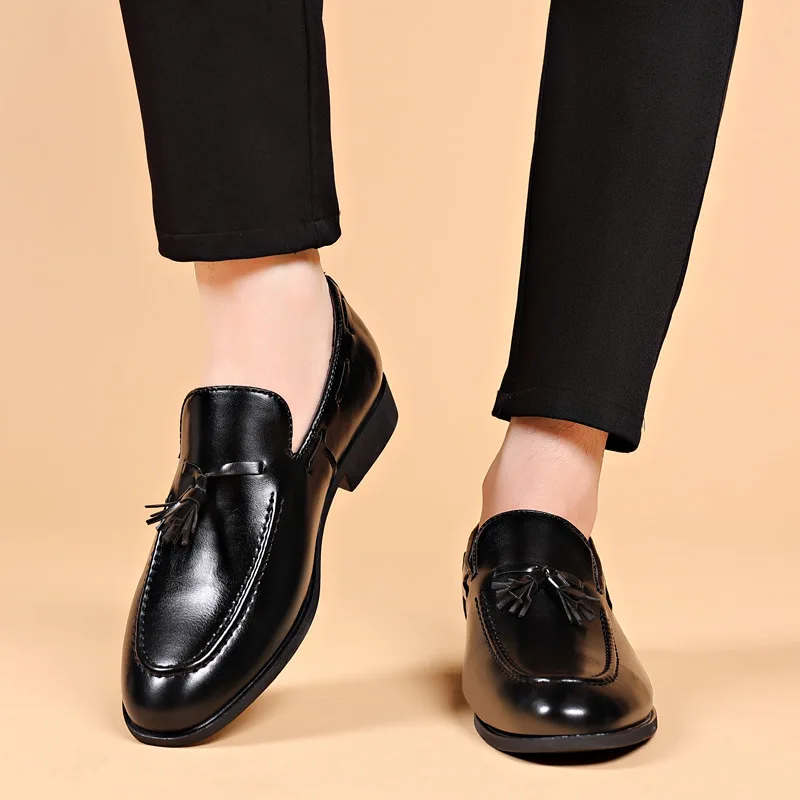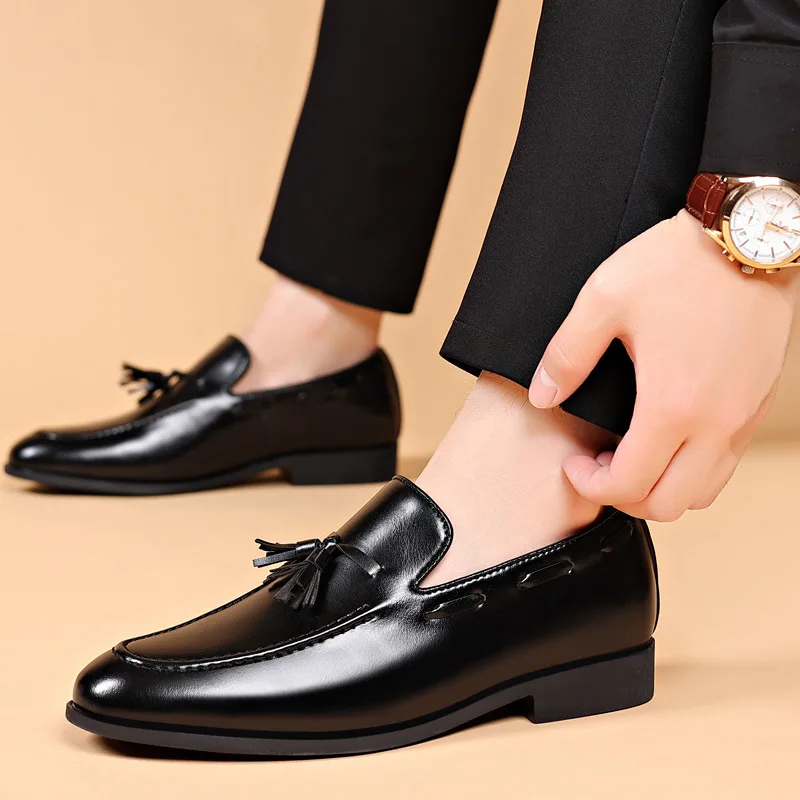The Evolution of Shoe Soles: From Leather to Rubber
For as long as we have walked, soles have protected our feet. Initially, leather was the sole option. Dependable, it has carried us from the earliest civilizations to today’s bustling cities.

Greek Sandals to Modern Dress Shoes: Leather’s Journey
Leather soles began with simple sandals in ancient Greece. Over time, these evolved into today’s refined leather sole dress shoes. Kings and commoners alike have enjoyed leather’s luxury underfoot.
The Invention of Rubber Soles and Their Impact
The late 1800s saw the birth of rubber soles, revolutionizing footwear. Lightweight and durable, they adapted quickly to various shoe styles. Post-World War I, rubber got popular, especially for sports and outdoor activities.
Leather vs Rubber Soles: Understanding the Differences
When we talk about dress shoes, the sole is key. It’s not just about looks. Comfort, durability, and use play a big role. Leather and rubber soles have their own benefits. We need to know these to choose the right shoe.
Characteristics of Leather Soles in Dress Shoes
Leather soles are classic. They speak of tradition and elegance. They start out stiff but mold to your feet over time. This makes them very comfy. Plus, they let your feet breathe. This is good for foot health.
But, leather soles have a downside. They don’t handle wet weather well. Water can damage them. So, they need more care. They aren’t as durable as rubber, especially on rough terrain.
Advantages of Rubber Soles in Various Footwear
Rubber soles are tough. They last a long time. They’re good for all weathers, especially rain and snow. They offer more grip and are flexible from the start. This means they’re comfy right away.
Rubber soles are versatile. You can find them on sports shoes, work boots, and even some dress shoes. They’ve become a modern choice for many, offering a blend of comfort and durability that leather soles can’t always match.
Durability and Longevity Comparisons
When comparing shoe soles, durability is a major factor. Let’s examine which material lasts longer.
Which Shoe Sole Stands the Test of Time?
For long-lasting wear, rubber soles take the lead. They withstand rough surfaces and frequent use. Unlike leather, they don’t wear down as quickly on city streets or during outdoor activities. Leather soles offer resilience, but they’re better suited for formal settings where there’s less abrasion.
It’s also important to consider sole care. Proper maintenance can extend the life of both types of soles. Regular polishing and repairs for leather, and cleaning for rubber, are key to longevity.
Weather Resistance of Leather vs Rubber Soles
Leather soles are not fans of wet weather. Rain and snow can harm them, causing the material to rot if not dried properly. On the other hand, rubber soles excel in adverse conditions. They resist water well and don’t degrade easily with exposure to the elements.
To sum up, rubber soles outlast leather in toughness and weather resistance. Leather needs more care, but it can be durable too with the right attention.

Comfort and Flexibility Factors
When choosing dress shoes, comfort and flexibility are as important as style. Both leather and rubber soles have unique features. Knowing them helps pick the right shoe for you.
Breaking In Leather Soles: Comfort over Time
Leather soles need time to break in. They start out stiff but get softer with wear. Your feet shape them over time. This means they become more comfortable as they mold to your walk. Leather sole dress shoes feel like they are made just for you after a while. They need care, but the pay-off is a custom-like fit for your feet.
Rubber Soles: Immediate Flexibility and Shock Absorption
Rubber soles are different. They offer flexibility right away. There’s no need to break them in. They also have shock-absorption. This is great for keeping your feet comfy. Walking or standing for long periods is easier with rubber soles. They have a bouncy feel that makes each step lighter. For active use or rainy days, rubber soles are a smart choice.
The Aesthetic Appeal of Shoe Soles
The shoe sole is not just a protector of our feet; it’s a statement of style and intent. Both leather and rubber soles have their own charm and appeal that cater to different aesthetics.
Leather Soles: The Epitome of Elegance
Leather soles are a symbol of sophistication. They are often paired with leather sole dress shoes. These shoes shine in formal events and business settings. Here’s why leather soles are classic:
- Timeless Style: Leather soles have a refined look that has stood the test of time.
- Rich Heritage: They carry a history of elegance from ages past.
- Custom Fit: With wear, they take on the shape of the wearer’s foot, adding to their distinctive appeal.
- Subtle Finish: Leather soles blend seamlessly with dress shoes. This adds to a sleek and polished appearance.
Yet, leather soles need attention. They can get scuffed and need care to stay elegant. The charm of leather is in its ability to age gracefully, with the scuffs telling a story of their own.
Rubber Soles: Casual Versatility and Modern Designs
Rubber soles bring a different vibe. They suit casual and modern footwear styles. They are a go-to for active lifestyles. Here are the reasons rubber soles are popular today:
- Practicality: They stand up well against the elements, making them practical for everyday use.
- Flexibility: Rubber soles bend easily. They’re comfortable from the start.
- Variety: With many designs, rubber soles fit into casual and even some formal shoes.
- Traction: They offer good grip, which is important for safety.
The versatility of rubber soles means they can suit anyone. Whether it’s an adventurer or someone who prefers a casual look, rubber soles can match the style needed. They’ve also found their way into the world of formal shoes. But they do so without reaching the same level of elegance as leather.
Specialized Sole Materials and Technologies
As the footwear world evolves, so do the materials and technologies behind shoe soles.
High-Density Rubber and Innovative Sole Options
High-density rubber has become a top choice for durability. It’s heavy-duty and stable. Sole designs often include grip enhancements, like treads for better traction. Lighter options, like blown air rubber soles, are also popular. They offer comfort reminiscent of sneakers. This innovation means we don’t have to choose between comfort and resilience.
The Role of Vibram in Sole Quality and Durability
Vibram is a leader in quality sole manufacturing. Their soles are light, offer great grip, and are super durable. They also bring serious shock-absorption, which helps keep your feet comfortable all day. Thanks to Vibram, even the most active individuals can find a reliable shoe sole option.

Sole Replacement and Maintenance
Caring for the soles of your shoes is critical. Proper maintenance can prolong their life and comfort.
The Importance of Proper Sole Care
Good sole care keeps shoes looking sharp and functional. It prevents quick wear and protects your investment. Regular cleaning and treating for leather, and inspection for rubber, are key. For leather soles, avoid wet conditions or treat them with waterproofing agents. For rubber soles, clean off debris that can wear them down.
Options for Extending the Life of Your Dress Shoes
To extend shoe life, consider these tips. For leather sole dress shoes, use protective rubber overlays when needed. They shield the leather from harsh surfaces. Also, have a cobbler replace soles when they are worn out. For rubber soles, resoling is possible, too. Look for quality brands like Vibram for replacements. Regular maintenance makes a big difference. Polish leather soles and keep rubber soles clean. Choose the right sole based on your shoe’s purpose, and you’ll enjoy them longer.